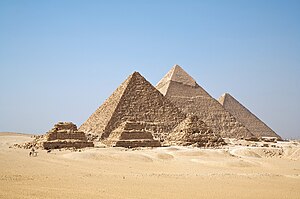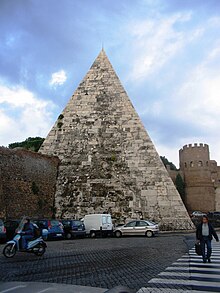Pyramid
This article needs additional citations for verification. (August 2006) |
- For other meanings, see pyramid (disambiguation).

A pyramid is any three-dimensional structure where the upper surfaces are triangular and converge on one point (apex). The base of pyramids are usually quadrilateral or trilateral (but generally may be of any polygon shape), meaning that a pyramid usually has four or three sides. The measurements of these triangles uniformly classify the shape as isosceles and sometimes equilateral.
Ancient monuments
Pyramid-shaped structures were built by many ancient civilizations.
China
There are many flat-topped pyramids in China. The First Emperor of Qin (circa 221 B.C.) was buried under a large pyramid outside modern day Xi'an. In the following centuries about a dozen more Han Dynasty royals were also buried under flat-topped pyramidal earth works.
Egyptian pyramids

The most famous pyramids are the Egyptian pyramids — huge structures built of brick or stone, some of which are among the largest man-made constructions. In Ancient Egypt, a pyramid was referred to as mer, literally "place of ascendance." The Great Pyramid of Giza is the largest in Egypt and one of the largest in the world. Until Lincoln Cathedral was built in 1300 A.D., it was the tallest building in the world. The base is over 13 acres in area.
It is one of the Seven Wonders of the World, and the only one of the seven to survive into modern times. The Ancient Egyptians capped the peaks of their pyramids with gold and covered their faces with polished white limestone, though many of the stones used for the purpose have fallen or been removed for other structures.
France
There is a Roman era pyramid built in Falicon, France. There were many more pyramids made in France in this period.
India

Many giant granite temple pyramids were made in South India during the Chola Empire, many of which are still in religious use today. Examples of such pyramid temples include Brihadisvara Temple at Thanjavur, the Temple of Gangaikondacholisvaram and the Airavatesvara Temple at Darasuram. However the largest temple pyramid in the area is Sri Rangam in Srirangam, Tamil Nadu. The Brihadisvara Temple was declared by UNESCO as a World Heritage Site in 1987; the Temple of Gangaikondacholisvaram and the Airavatesvara Temple at Darasuram were added as extensions to the site in 2004.[1]
Mesoamerican pyramids

A number of Mesoamerican cultures also built pyramid-shaped structures. Mesoamerican pyramids were usually stepped, with temples on top, more similar to the Mesopotamian ziggurat than the Egyptian pyramid. The largest pyramid by volume is the Great Pyramid of Cholula, in the Mexican state of Puebla. This pyramid is considered the largest monument ever constructed anywhere in the world, and is still being excavated. There is an unusual pyramid with a circular plan at the site of Cuicuilco, now inside Mexico City and mostly covered with lava from an ancient eruption of Xictli. Pyramids in Mexico were often used as places of human sacrifice.
Mesopotamian pyramids
The Mesopotamians also built pyramids, called ziggurats. In ancient times these were brightly painted. Since they were constructed of mud-brick, little remains of them. The Biblical Tower of Babel is believed to have been a Babylonian ziggurat.
North American pyramids
Many mound-building societies of ancient North America built large pyramidal earth structures known as platform mounds. Among the largest and best-known of these structures is Monk's Mound at the site of Cahokia, which has a base larger than that of the Great Pyramid at Giza. While the North American mounds' precise function is not known, they are believed to have played a central role in the mound-building people's religious life.
Nubian pyramids
Nubian pyramids were constructed (roughly 220 of them) at three sites in Nubia to serve as tombs for the kings and queens of Napata and Meroë.
The Nubians built more pyramids than the Egyptians, but they are smaller. The Nubian pyramids were constructed at a steeper angle than Egyptian ones and were monuments to dead kings[citation needed].
Pyramids were still being built in Nubia up to AD 300.
Rome

The 27-meter-high Pyramid of Cestius was built by the end of the first century BC and still exists today, close to the Porta San Paolo. Another one, named Meta Romuli, standing in the Ager Vaticanus (today's Borgo), was destroyed at the end of the 15th century.
These Roman imitations of Egyptian monuments are important as contemporary "portraits" of the Egyptian ones, providing some sense of their original color and smoothness.
Medieval Europe
Pyramids have occasionally been used in Christian architecture of the feudal era, e.g. as the tower of Oviedo's Gothic Cathedral of San Salvador. In some cases this leads to speculations on masonic or other symbolical intentions.
Modern pyramids
Examples of modern pyramids are:
- The Louvre Pyramid in Paris, France, in the court of the Louvre Museum, is a 20.6 meter (about 70 foot) glass structure which acts as an entrance to the museum. It was designed by the American architect I. M. Pei and completed in 1989.
- The Transamerica Pyramid in San Francisco, California, designed by William Pereira.
- The 32-story Pyramid Arena in Memphis, Tennessee (built in 1991) was the home court for the University of Memphis men's basketball program, and the National Basketball Association's Memphis Grizzlies until 2004.
- The Slovak radio building in Bratislava, Slovakia. This building is shaped like an inverted pyramid.
- The Walter Pyramid, home of the basketball and volleyball teams of the California State University, Long Beach, campus in California, United States, is an 18-story-tall blue pyramid.
- The Luxor Hotel in Las Vegas, United States, is a 30-story pyramid with light beaming from the top.
- The Summum Pyramid, a 3 story pyramid in Salt Lake City, Utah, used for instruction in the Summum philosophy and conducting rites associated with Modern Mummification.
- The Palace of Peace and Reconciliation in Astana, Kazakhstan.
- The three pyramids of Moody Gardens in Galveston, Texas.
- The Co-Op Bank Pyramid or Stockport Pyramid in Stockport, England is a large pyramid-shaped office block in Stockport in England. (The surrounding part of the valley of the upper Mersey has sometimes been called the "Kings Valley" after the Valley of the Kings in Egypt.)
- The GoJa Music Hall in Prague.
- The Muttart Conservatory greenhouses in Edmonton, Alberta.
- The unfinished Ryugyong Hotel in Pyongyang.
- Small pyramids similar to those of the Louvre can be found outside the lobby of the Citicorp Building in Long Island City, Queens NY.
Gallery
-
The Pyramid Arena in Memphis, Tennessee
-
Metairie Cemetery, New Orleans
-
Transamerica Pyramid
-
Stockport Pyramid in Stockport, United Kingdom
References
- Patricia Blackwell Gary and Richard Talcott, "Stargazing in Ancient Egypt," Astronomy, June 2006, pp. 62-67.
- Fagan, Garrett. "Archaeological Fantasies." RoutledgeFalmer. 2006
External links
- pyramids Surface Area MATHguide
- pyramids Volume MATHguide
- Paper models of pyramids Cheops pyramid and others








